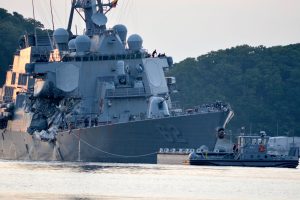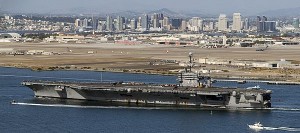 So the USS Fitzgerald got holed by a freighter. It is unfortunate and tragic that sailors lost their lives. The survivors managed to save their ship–carrying out the mission they’re trained to do, and the Navy, from the CNO down, did a good job of keeping everyone informed.
So the USS Fitzgerald got holed by a freighter. It is unfortunate and tragic that sailors lost their lives. The survivors managed to save their ship–carrying out the mission they’re trained to do, and the Navy, from the CNO down, did a good job of keeping everyone informed.
These things happen.
Coupled with efforts to acknowledge the crew’s efforts in saving the vessel, a grim accounting has begun. The always-eloquent John Kirby–with help from an eloquent Wall Street Journal Op Ed dug up by Bryan McGrath–sums up the next steps on a post over at CNN. In short, he details the accountability measures that’ll likely be meted out upon the crew responsible for hazarding the ship. It’s good. Read it. But what he does not address is systemic accountability. While it’s easy and cathartic to cheer the desperate teamwork that saved the ship while treating the disgraced as a single point failure and dispatching them from the service, it doesn’t help identify and solve any underlying problems that may have contributed to this disaster.
It is far harder to champion the relentless identification and rectification of systemic Navy failures. I fear, in the aftermath of this latest mishap, that the Navy will fall short, focusing on the Fitzgerald only, when the Fitz may be a symptom of a larger problem.
Let’s start with a blunt assertion.
 Ship Handling/Navigation Is Not A Navy Strength
Ship Handling/Navigation Is Not A Navy Strength
Since FY 2009, the Navy’s ship handling/navigation record has been, at best, checkered. Here’s the list of avoidable incidents:
- USS Antietam (CG grounding)
- USS Georgia (SSBN grounding)
- USS Louisiana (SSBN collision w/MSC vessel)
- USS Tortuga (LSD allision–$2.5 million)
- USS Taylor (FFG grounding–$5 million)
- USS Guardian (MCM grounding-total loss)
- USS Jacksonville (SSN collision–at least $2.5 million)
- USS Montpelier/USS San Jacinto (SSN/CG collision–over $80 million dollars in damages)
- USS Porter (DDG collision–$50 million dollars)
- USS Essex (LHD collision w/MSC vessel–$2,5 million)
- USS Port Royal (CG grounding–about $50 million in damage)
- USS Hartford/USS New Orleans (SSN/LPD collision–$120 million dollars of damage to the sub alone)
- USS Fitzgerald (DDG collision)
The bolded incidents resulted in serious damage. I’ve missed a few, but I’ll add in the Great 2016 Patrol Craft Debacle (navigation/prep/capture) for good measure.
There are a couple of ways to look at this record. Some out there might say that the Navy is doing alright. And, yes, I’d agree–but while the U.S. Navy is thankfully not suffering through the bad old days of 1989-91, when it seemed there were fires, collisions and other mishaps every day, the Navy’s recent record isn’t that great. Let’s not sugar-coat this. We’ve got a small enough fleet as it is, and the casualties listed above, if added to the maintenance mistakes and the fires (Remember the cigarette-sparked $70 million-dollar USS George Washington fire and the USS Miami arson debacle? And as a courtesy, I won’t even add in the LCS operational and maintenance SNAFUs), preventable accidents sidelined the equivalent of a carrier battle group.
Over the past decade, avoidable accidents “sunk” an SSN and MCM, severely disabled a CG, 2 DDGs, and 2 SSNs, and sidelined a CVN and CG at critical moments. The rest are essentially shorter-term mission kills.
That’s not a good record.
Despite all the rosy trend lines developed over at the Navy safety center, I’d urge somebody out there to go compare the U.S. Navy surface combatant mishap rates with mishap rates over at the Military Sealift Command, the USCG or the NOAA fleets. The results (when stripped of all the usual caveats, exceptions and defensive data shaping one encounters when comparing seamanship measures between National Fleet components) might serve as an eye-opening corrective.
I’m not paving new ground here. Anybody who reads the Navy investigation reports after these mishaps can’t help but acknowledge that bad seamanship is cited as a frequent contributor. The record suggests there are some systemic issues here that need action–training, more sea time, more work without electronic aids to navigation or…something.
It’s a gritty, ugly, self-reinforcing calculus–with so few ships, the Navy simply cannot afford mishaps when every ship is critical. So that leads to risk aversion, less time in complex sea situations, and then a further decline in sailing skill. The Navy has gotta thread the needle somehow–recognizing the critical nature of front-line assets, while allowing for development of navigational/warfighting mastery. For the Navy, the truism that “China will be broken” is right, and acceptable. Even some of the best Navy Admirals learned their craft by running their craft aground (it’s one of the reasons I value a high-low fleet mix).
But the “even Nimitz screwed up” defense wears thin after awhile. I mean, the Chinese Navy may not be following a training pathway that gets ships ready for “battle” in a timely fashion, but…they’re certainly methodically building up their seamanship skills. And, well, for that matter, when was the last time anybody heard about a Chinese Navy mishap? A grounding?
I’ve heard of one recent instance. That’ s it.
The Navy’s gotta do a better job at seamanship. The Navy community has been clucking about this for a long time, but…are things getting better? Or worse?
 Look Hard at Discipline:
Look Hard at Discipline:
I’m also a little worried about how today’s “break all the norms” and “rules are for suckers” attitudes might be impacting the fleet.
If naval leaders will not (or cannot?) vigorously enforce Navy standards, Navy rules and regulations, and fail to reinforce the idea that, by following the regs, each individual crew member supports the entire team aboard their vessel/command, it gets easier to start drawing lines of causation between, say, a sailor hiding out in an engine room for days as his fleet launches a huge Search and Rescue effort, or somebody tossing trash disks over the side for no discernible reason….to, ah, somebody, oh, sleeping on watch or neglecting some other mission-critical duty.
Accidents happen when nobody gives a damn about the other members of the team.
One need only look at the events that led to the Iranian capture of U.S. sailors (or the Fat Leonard Scandal). Members of the Navy community who know better just aren’t following the rules and regulations. Now, I’m no sticker for rules and regs, but often these things were proven out in blood and were put in place to save sailor’s lives.
So…I am worried. I am concerned some sailors and some officers aren’t even aware that their actions (or lack oversight) affect the lives of many of their colleagues. And that’s really disturbing–not just because one bad apple can make everybody who is doing their job well look bad, but because it’s really really hard to change course when more and more personnel–from the admiral on down–pick the easy route.
 Conclusion:
Conclusion:
So. The Fitz is still holed by a freighter. Join in and cheer the crew that got the Fitzgerald back to port, weep for the dead and share the sadness as responsible parties aboard–and likely often good people–are identified and punished for what could have been a momentary lapse, or a simple mistake or a wholesale failure of the crew or..anything.
But don’t stop there. Don’t stop with the board investigation findings.
We owe it to those lost to take a hard and unsparing look at the institution.
If sailors and officers are contributing to preventable accidents….if Navy personnel are failing each other by neglecting what they perceive as nitnoid rules, regs and practices, then the system has a problem that needs fixing.
Stamping out any of this sort of rot that exists (if it does) might be a good challenge for a future SECNAV.

{ 3 trackbacks }
{ 0 comments… add one now }